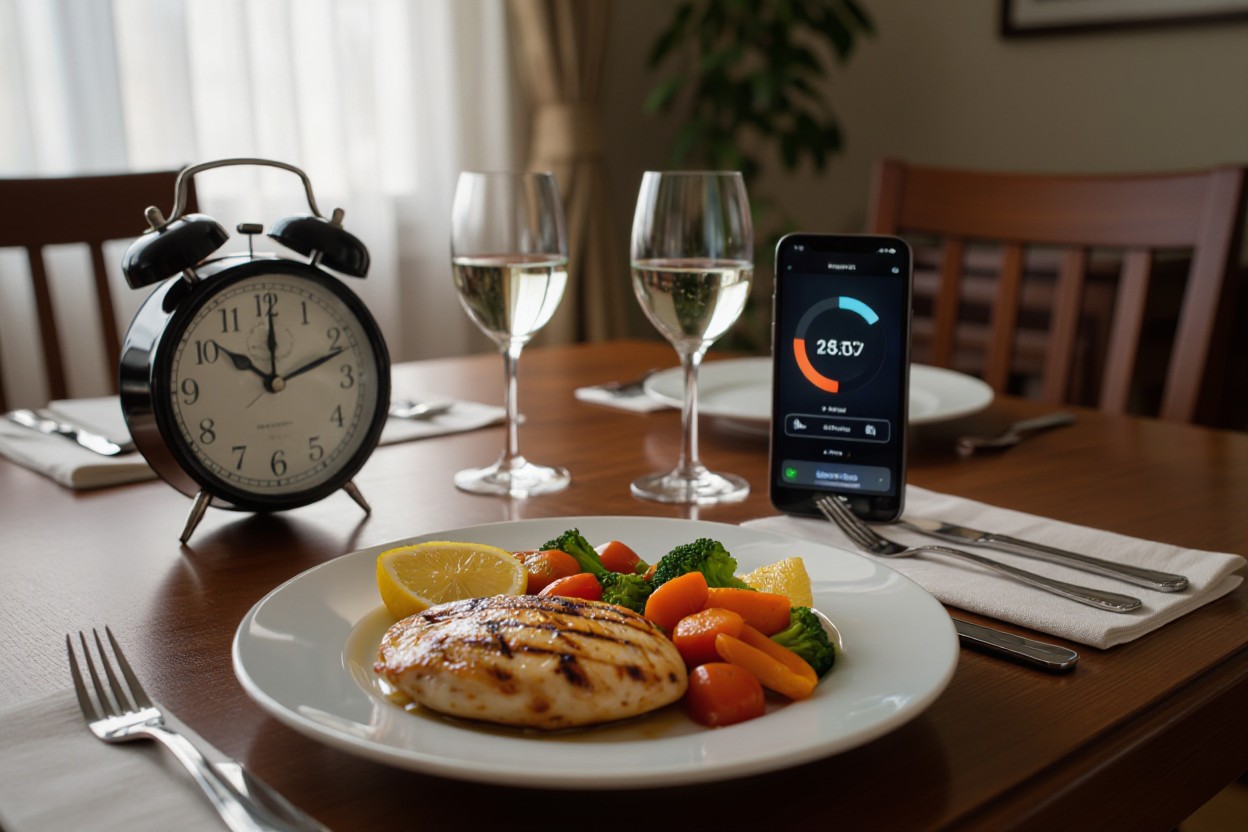Feeling stuck? Perhaps you’ve been trying to manage your weight, boost your energy, or feel more at ease in your own body, but nothing seems to stick. You’ve followed the rules—eat less, move more, snack every few hours—and yet, the results are frustratingly absent.
Here’s the deal: The idea that we must eat constantly throughout the day is a modern myth. Our bodies are actually designed for rhythm, for periods of eating and periods of rest.
What if you could tap into this ancient rhythm to unlock a range of benefits, from effortless weight management to enhanced mental clarity and improved metabolic health?
This is the promise of intermittent fasting (IF). And as leading experts, such as Dr. Jason Fung, have shown, it’s one of the most potent tools for resetting your metabolism [1]. This isn’t about a restrictive diet. It’s about changing when you eat, not just what you eat.
If you’re ready to learn how to start intermittent fasting without the confusion and overwhelm, you’re in the right place. This guide offers a straightforward, step-by-step plan to help you start your journey today.
Key Takeaways:
- Intermittent fasting is an eating pattern—specifically, timing over calories—that lowers insulin levels to support weight loss and metabolic health. It also triggers autophagy, increases BDNF for brain health, and reduces inflammation.
- Begin gently (14:10 → 16:8) or use a 5:2 approach for weekly flexibility. Choose an eating window that suits your lifestyle and follow a simple 5-step startup plan. Women may need to progress more slowly and adjust to their cycle.
- Maintain a “clean” fast with water, black coffee, or plain tea to avoid insulin responses. Prioritize whole, unprocessed foods during eating windows, stay hydrated, and avoid aggressive fasting or bingeing. Plan protein-rich meals to protect muscle and maintain results.

What Is Intermittent Fasting (And What It’s Not)
Let’s clear this up right away. Intermittent fasting is not a diet. It’s an eating pattern.
You cycle between periods of eating (your “eating window”) and periods of not eating (your “fasting window”).
Intermittent fasting is NOT:
- Starvation: It’s a controlled, voluntary break from eating for a set period.
- A license to eat junk food: The quality of your food still matters immensely.
- Complicated: Once you find a rhythm, it can be the simplest eating pattern you’ve ever followed.
Think of it this way: you already fast every night while you sleep. Intermittent fasting is essentially about consciously extending the natural fast a little longer to unlock your body’s innate healing mechanisms.
Why Bother? The Science-Backed Benefits of Fasting
When you give your body a break from constant digestion, extraordinary things begin to happen. Your hormones shift, your cells repair themselves, and your body starts to use its fuel more efficiently.
Here are some of the key benefits:
- Effortless Weight Loss: Lower insulin levels allow your body to access and burn its stored fat for energy. Many people find they can lose weight without strict calorie counting [1].
- Improved Insulin Sensitivity: Fasting helps reverse insulin resistance, a key driver of type 2 diabetes and metabolic syndrome. This is a cornerstone of protocols found in The Diabetes Reversal Revolution [2].
- Cellular Cleanup (Autophagy): Fasting triggers a process called autophagy, in which your body removes old, damaged cells and proteins. Think of it as cellular spring cleaning that can reduce inflammation and support longevity [3].
- Enhanced Brain Health: Fasting can increase a brain hormone called BDNF (Brain-Derived Neurotrophic Factor), which may help grow new neurons and protect against conditions like Alzheimer’s disease [4].
- Reduced Inflammation: Chronic inflammation is at the root of many modern diseases. Studies show that intermittent fasting can significantly reduce markers of inflammation [5].
The 3 Easiest Intermittent Fasting Schedules for Beginners
The key to starting intermittent fasting is to choose a schedule that fits your lifestyle. You don’t need to jump into a 24-hour fast. Here are the three most popular and effective methods for beginners.
Method 1: The 16:8 Method (The Best for Most Beginners)
This is the most popular form of IF for a reason: it’s effective, sustainable, and easy to adapt.
- The Rule: You fast for 16 hours and eat all your meals within an 8-hour window.
- Example: You finish dinner at 8 PM and don’t eat again until 12 PM the next day. Your eating window is from 12 PM to 8 PM.
- Why it works: You’re essentially just skipping breakfast and pushing your first meal of the day to lunchtime. Most of your fasting window happens while you’re asleep.
Method 2: The 14:10 Method (The Gentle Start)
If 16 hours feels too daunting, this is the perfect starting point.
- The Rule: You fast for 14 hours and have a 10-hour eating window.
- Example: Finish dinner at 8 PM and eat your first meal at 10 AM the next day.
- Why it works: This is a fantastic way to ease your body into fasting. You can practice this for a week or two, and then transition to a 16:8 schedule if you feel ready.
Method 3: The 5:2 Diet (The Weekly Reset)
This method involves eating normally for five days a week and restricting calories on two non-consecutive days.
- The Rule: On two days of the week, you eat only 500-600 calories. On the other five days, you eat as you usually would.
- Why it works: It offers flexibility for those who don’t want to fast every day. However, many beginners find tracking calories on fasting days more difficult than simply watching the clock with the 16:8 method.
The bottom line is this: For most beginners, the 16:8 method (or starting with 14:10) is the most straightforward and most sustainable path to success.
Your Step-by-Step Plan: How to Start Intermittent Fasting This Week
Ready to begin? Here’s your simple, 5-step plan.
Step 1: Choose Your Schedule
Pick one of the methods above. We highly recommend starting with 14:10 for a few days, then moving to 16:8. Don’t be a hero; ease into it.
Step 2: Pick Your Eating Window
Look at your daily routine. When does it make the most sense to eat?
- If you’re not a big breakfast person, a window of 12 PM to 8 PM is perfect.
- If you prefer an earlier dinner, you might choose 10 AM to 6 PM.
Write it down. This is your goal.
Step 3: Prepare for Your First Fast
The night before you start, eat a satisfying dinner rich in protein, healthy fats, and fiber. This will help you feel fuller for a longer period. Hydrate well before bed.
Step 4: Survive Your First Fasting Window
This is where most beginners get nervous, but it’s simpler than you think. Your goal during the fast is to consume zero calories. Focus on hydration. (More on what you can drink below). Stay busy! The morning of your first fast is a great time to tackle a project to keep your mind off food.
Step 5: Break Your Fast Gently
When your eating window opens, don’t go crazy. Your first meal should be a normal-sized, nutrient-dense meal. Focus on protein, vegetables, and healthy fats. Avoid starting with a large meal of refined carbs, as this can cause a blood sugar spike and leave you feeling sluggish.
What Can You Drink While Fasting? (The “Clean Fast” Rules)
To reap the full benefits of fasting, particularly in terms of lowering insulin, it’s crucial to stick to non-caloric beverages. Dr. Eric Berg refers to this as keeping the fast “clean” to avoid any insulin response [6].
Your go-to fasting drinks are:
- Water: Flat or sparkling. This is your best friend. Drink plenty of it.
- Black Coffee: No sugar, cream, milk, or artificial sweeteners.
- Plain Tea: Green, black, oolong, or herbal teas are all fine. Again, nothing added.
That’s it. Anything with calories (even a splash of milk in your coffee) can technically break your fast by causing an insulin release.
Common Mistakes Beginners Make (And How to Avoid Them)
- Starting Too Aggressively: Don’t jump into an 18 or 20-hour fast on day one. Start with 14:10 and let your body adapt.
- Forgetting to Hydrate: Mild dehydration can often be mistaken for hunger. Drink water consistently throughout your fasting window.
- Bingeing When the Fast Ends: This defeats the purpose. Plan a healthy, normal-sized meal to break your fast. Overeating can cause digestive discomfort and negate the benefits of a healthy diet.
- Eating Poor-Quality Food: You can’t fast for 16 hours and then eat junk for 8 hours and expect great results. Prioritize whole, unprocessed foods as described in books like The Great Health Deception [7].
Frequently Asked Questions (FAQ)
1. Will I lose muscle while intermittent fasting?
This is a common concern, but it’s unfounded mainly for most people. Studies show that IF is very effective at preserving muscle mass during weight loss, especially when you eat adequate protein during your eating window [1].
2. Can women do intermittent fasting?
Yes, absolutely. However, some women may need to be more mindful of their cycle and start more slowly. Barbara O’Neill frequently emphasizes the importance of listening to the body’s natural rhythms [8]. If you experience any adverse effects, try a shorter fasting window (like 14:10).
3. How long until I see results?
Some people feel benefits like reduced bloating and more energy within the first few days. Noticeable weight loss can take 2-4 weeks of consistency. The key is patience.
4. What if I feel hungry?
Hunger comes in waves. When it hits, drink a large glass of water or a cup of black coffee. Stay busy for 15-20 minutes, and you’ll often find the wave passes. Your body will adapt after the first week!
Your Journey Starts Now
Learning how to start intermittent fasting is about giving your body the rest it needs to heal and thrive. It’s a simple, flexible, and powerful tool that puts you back in control of your health.
Start slow, listen to your body, and be consistent. You have the power to reset your metabolism and transform your well-being, one fasting window at a time.
Ready to take the next step and get all the tools you need for success? Download our FREE “Beginner’s Guide to Intermittent Fasting” which includes sample meal plans, fasting schedule templates, and a progress tracker to get you started today!
REFERENCES
[1] Fung, J. (2016). The Obesity Code. Greystone Books.
[2] Snouda, S. The Diabetes Reversal Revolution. (From knowledge base).
[3] Fung, J. The Advanced Topics Code: Exploring the Frontiers of Fasting. (From knowledge base).
[4] Mattson, M. P. (2005). Energy intake, meal frequency, and health: a neurobiological perspective. Annual Review of Nutrition, 25, 237–260.
[5] Aksungar, F. B., Topkaya, A. E., & Akyildiz, M. (2007). Interleukin-6, C-reactive protein and biochemical parameters during prolonged intermittent fasting. Annals of Nutrition & Metabolism, 51(1), 88–95.
[6] Berg, E. DR. BERG’S COMPREHENSIVE GUIDE TO METABOLIC HEALTH. (From knowledge base). [7] Snouda, S. The Great Health Deception. (From knowledge base).
[8] O’Neill, B. The 8 Laws of Health & Lifestyle Medicine. (From knowledge base).

